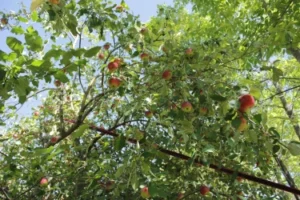Indian Scientists Searching for the
Perfect Apple

Apples are not just fruits in India—they’re a way of life for thousands of farmers across the hills
of Himachal Pradesh, Jammu & Kashmir, and Uttarakhand. But today, this beloved
crop is under pressure. Climate change, disease, and changing market demands have made
apple farming a risky business.
That’s why a team of dedicated Indian scientists is on a mission: to find or create the
“perfect apple.”
What’s Wrong with the Apples We Already Have?
Traditional apples like Royal Delicious and Red Delicious have been grown in India for
decades. But these varieties are now struggling. Here’s why:
-
Rising temperatures are affecting the chilling hours apples need to flower and fruit properly.
-
Unpredictable weather—hailstorms, sudden rains—are damaging the crops.
-
Diseases and pests are spreading faster.
-
Market expectations are rising; consumers want better-looking, longer-lasting apples.
Clearly, it’s time for an upgrade.

The Science Behind a Better Apple
Across research centers like Dr. Y.S. Parmar University in Himachal and CITH Srinagar,
scientists are working hard to change the apple game.
Here’s how:
1. Hybrid Varieties
By cross-breeding apples, they’re developing fruits that are:
-
Sweeter and crunchier
-
Uniform in shape and color
-
Resistant to disease
-
Longer-lasting after harvest
2. Imported Apple Stars
Scientists are testing famous apple types from countries like the USA, New Zealand, and
Italy —such as Fuji, Gala, and Scarlet Spur—to see how well they grow in India.
3. Low-Chill Apples
To beat climate change, they’re developing low-chill varieties—apples that grow even in
warmer areas where apples never grew before!
4. Biotech Magic
Using tissue culture and gene mapping, researchers are cloning successful trees and
analyzing which genes help with size, color, sweetness, and resistance.

Early Success Stories
Some early wins in the apple revolution include:
-
HRMN-99, an apple variety created by a farmer in Himachal, grows even in plain areas with little cold.
-
Dwarf rootstock trees that fruit faster (within 2–3 years) and take up less space—perfect for modern orchards.
-
International varieties that are now being successfully grown in Indian soil.
Why This Mission Matters
This isn’t just about creating tastier apples.
It’s about:
-
Saving farmer livelihoods
-
Adapting to climate change
-
Producing export-quality apples
-
Reducing apple imports
-
Creating opportunities in new regions

Final Bite
The journey to the perfect apple isn’t just happening in labs—it’s happening in orchards,
greenhouses, and hillside farms. With science, tradition, and a bit of global flavor, India is
reshaping its apple story—one crunch at a time.

